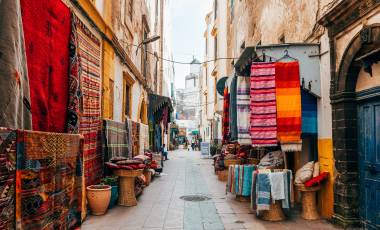Only a couple of decades ago, many vegetarians may have feared that the only dishes available to them while travelling would consist of bland lettuce, tough flatbread, and tasteless tofu – but thankfully times have changed. Now, there’s a whole host of dishes across the world that are incredibly fresh, incredibly creative and most importantly, completely meat-free.
From vibrant coloured chickpea curries in Malaysia to delicious vegetarian tagines in Morocco, we’ve collected some of our favourite vegetarian-friendly destinations below and their mouth-watering dishes that would convert even the most dedicated carnivores.
Sicily, Italy
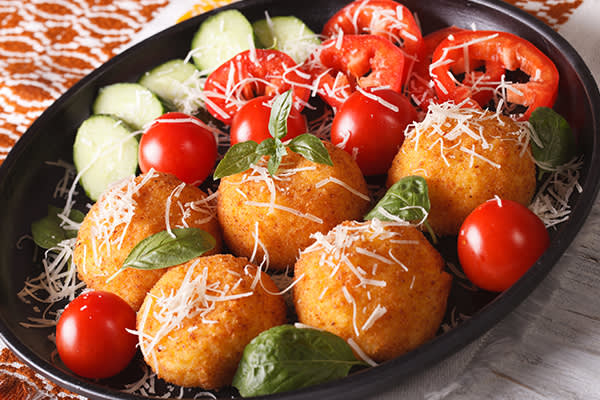
Sicilian cuisine is incredibly unique. This Italian region has been shaped by 13 different empires over the course of three millennia, with each one leaving a distinctive mark on Sicilian cooking. With Italian, Greek, Spanish, French and Arab influences playing a prominent role in some of the region’s favourite dishes, you’d be surprised to know that vegetarian options aren’t that hard to come by.
Blessed with a temperate climate, orange and lemon groves, almond trees, olive farms and vineyards are peppered around almost every corner of the island, making their way into almost every meal. In the summer, quench your thirst by grabbing a cool glass of spremuta d’arancia, (freshly squeezed orange juice) from one of their quaint coffee bars, while tucking into Insalata di arance, a Sicilian orange salad. Consisting of fresh green onion, chia seeds, blood orange and oregano, the salad is adorned with shaved fennel, pitted green and black olives, sea salt and Sicilian extra virgin olive oil.
However, one of the most famous Sicilian dishes is Pasta alla Norma. This delicious short pasta meal is cooked with eggplant in a light tomato sauce and served with ricotta salata. Arancini is another firm favourite with the locals. These fried rice balls are made in many different ways that are suitable for vegetarians. We would recommend trying those that are stuffed with spinach, mushrooms and eggplant or those laced with ragu sauce, mozzarella and green peas for a delightfully filling starter.
When it comes to Italian desserts, Sicily is king. Taking a prime position on nearly every Sicilian dessert menu is their velvety cannoli. Made with melt-in-your-mouth ricotta that’s wrapped in a crispy wafer, they’re usually topped with candied fruit, decadent chocolate drops or pistachio flakes. Why not try these appetizing Italian dishes for yourself on our Treasures of Sicily trip that allows you to explore some of the region’s best archaeological sites and picturesque villages?
Find out more information on our Treasures of Sicily trip here >>>
Malaysia
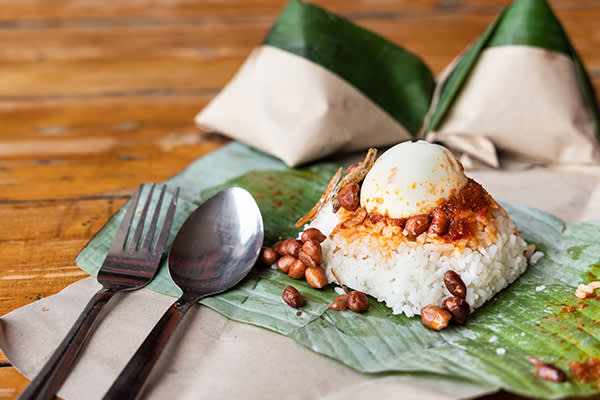
Back in the early 15th century, Malacca, (Melaka), a small fishing village on the west coast of the Malay Peninsula was one of the most significant trading ports in Southeast Asia, which in turn played a huge role in the diversity of Malay cuisine. Over the years, local cooking became influenced by the arrival of new international exports, such as pepper, clove, cardamom and other exotic vegetables, which helped to produce an incredible variety of flavours in their dishes.
Shaped by a myriad of cultures such as Chinese, Indian Siamese, Minangkabau and Arab, Malaysia’s rich culinary heritage continues to delight every traveller. And when it comes to delicious vegetarian cuisine, you’ll be spoilt for choice.
Their range of strong, spicy and aromatic vegetarian dishes can be found at nearly every restaurant, roadside stall or food truck. One of our personal favourites is Malaysia’s vegetarian nasi lemak bungkus. This meal consists of rice steamed in coconut milk and aromatic pandan leaves, served with chopped roasted peanuts, sliced cucumber and a hard-boiled egg that’s lathered in fiery sambal (local chilli paste). This typical hot street-food feast is tightly wrapped in a banana leaf and wax brown paper, so you can easily eat on the move. Malaysian curry empanadas are also a popular snack choice for vegetarians as they’re filled with a delicious combination of sweet potato cubes, green peas, curry leaves, chickpeas, coconut cream and spicy garlic paste.
For an instant crowd-pleaser, we’d recommend trying their Malaysian butternut squash laksa, a rice noodle broth brewed with ginger, fresh lemongrass, spicy chilli peppers, lime leaves and creamy coconut milk. When it comes to deserts in Malaysia, the cooler the better, and nothing hits the spot quite like ice cendol. This refreshing bowl of shaved ice is topped with coconut milk, red beans, palm sugar syrup, sweet corn kernels, and jelly noodles. It’s the perfect way to combat the Malaysian heat.
Looking to try these Malaysian treats? Our Borneo and the Malaysian Peninsula trip gives you plenty of opportunities to try the local cuisine in Penang and Malacca (Melaka) alongside unforgettable wildlife encounters in Sepilok and the Kinabatangan River.
Find out more information about our Borneo and the Malaysian Peninsula trip here >>>
Northern India
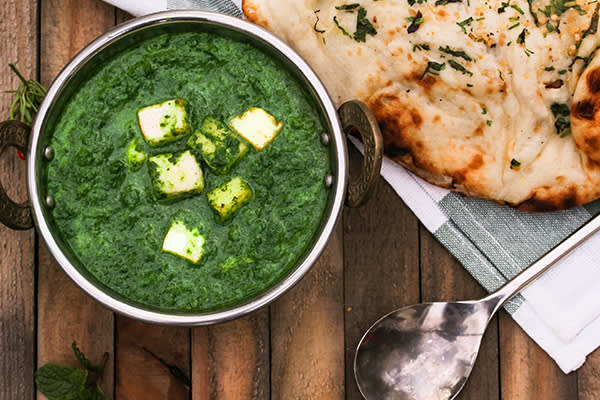
Did you know there are more vegetarians in India than in the rest of the world combined? Vegetarianism largely stems from religious ideals when Buddhism, Hinduism and Jainism were gaining popularity around 500BCE. India’s lush fertile land also allowed for the growth of a wide variety of vegetables, beans and grains. With great accessibility to these fresh ingredients, you’ll find that they’re a prominent feature in Indian cuisine, particularly in the North.
Throughout history, highly respected figures like Chaitanya Mahaprabhu and Mahatma Gandhi have actively promoted a meat-free lifestyle. So, from spicy curries packed with lentils, sweet potato and cauliflower to traditional street snacks such as dosa, the array of vegetarian recipes on offer are quite impressive.
Vegetarian snacks in the heady streets stalls in the Pink City of Jaipur are plentiful and delicious, whether you’re looking to try spiced potato and pea fritters with sweet and sour chutney or Okra with panch phora and lemon.
If you’re wanting something a bit more filling in the evening, the rich, tomato-based chickpea curry, Chana masala with yoghurt and flatbread will hit the spot. For dessert, why not try Gulab jamun, a golden coloured semolina dumpling, bathed in saffron syrup? On our Highlights of Northern India, you’ll get the opportunity to visit these vibrant markets and street stalls for yourself to try the local fare, after exploring Jaipur’s City Palace, the striking Hawa Mahal and the splendid Amber Fort.
Find out more information on our Highlights of Northern India trip here >>>
Morocco, North Africa
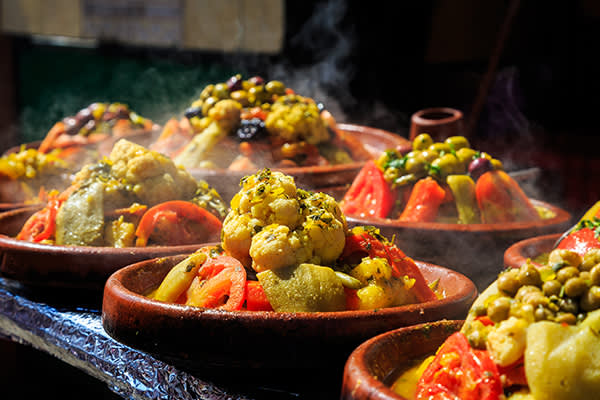
You’ll be surprised to know that most Moroccan dishes date back to when nomadic Berbers inhabited the region over 2,000 years ago, with their food staples consisting of locally grown ingredients such as dates, figs olives and meat. However, ancient traders and conquerors including the Romans, Carthaginians, Phoenicians and Arabians, introduced new recipes, ingredients and spices that heavily influenced the Moroccan cuisine we know and love today. In addition to the ginger, saffron, cinnamon, caraway and cumin the Arabs brought to Morocco, they also introduced the concept of sweet and sour cooking to indigenous communities.
The combination of these spices and Morocco’s flavoursome crops such as hot peppers, figs, tomatoes, dates and oranges continue to elevate everyday meals into rich culinary experiences. In Marrakech particularly, their diverse menus usually offer a wide variety of fresh, meat-free dishes. With a colourful array of vegetables included in most meals, there’s much more to meet the vegetarian eye than Moroccan flatbread.
A go-to dish for any vegetarian visiting Morocco has to be their steaming vegetable tagine. Commonly cooked with garlic, onion, pumpkin, dates, ginger, tomatoes, garlic, carrots, chickpeas and zucchini, vegetable tagines are often seasoned with a range of different spices. The cumin, cinnamon, turmeric and saffron alongside the chopped nuts and dried fruit garnish gives the dish that added bit of crunch, complexity and sweetness.
Another typically traditional dish is Berkoukech soup (Mhamsa). While usually made with red meat, many places also offer a vegetarian alternative. This simple, yet earthy tomato-based broth is made with pearl couscous, chickpeas, fresh coriander, saffron and an assortment of vegetables, which is perfect for a colder evening in the Moroccan desert.
When it comes to dessert, the locals love their small, sweet pastries and Moroccan mint tea. We’d recommend trying their sweet briouats. These triangular fried, honey-coated pastries are usually filled with almond paste, cinnamon and orange flower water, making them a great accompaniment to any meal. On our Highlights of Morocco trip, you can enjoy these dishes while exploring the labyrinth streets of the ancient medina in Marrakech, alongside visiting the Roman ruins of Volubilis and the impressive Todra Gorge.
Find out more information on our Highlights of Morocco trip here >>>
Lima, Peru

From heady market stalls and traditional, home-cooked dishes to top-notch Michelin-starred fare, there’s no doubt Lima is experiencing a creative culinary awakening. Peru’s deeply rooted customs and traditions continue to influence the country’s cuisine to offer unique dining experiences. And it’s not just their fresh ceviche that’s turning heads. Increasingly, restaurants in Lima are incorporating their electric mix of locally grown organic vegetables, grains, fruits and Peruvian spices to create culinary masterpieces suitable for vegetarians that go way beyond rice and corn.
Peruvian cuisine may have originated from the indigenous pre-Inca and Inca populations, but over time, dishes began to be influenced by the Spanish, Italian and Germans. As routes for travel continued to open, travellers from China, Japan, West Africa and France transformed Peruvian cooking even further. This melting pot of influences meant that families adapted their home recipes, but the local Peruvian staple ingredients remain an important element in Peruvian dishes, including legumes (chocho, lima bean), corn, kaniwa, maca, potatoes and other tubers.
Peppered across Barranco in Lima, the buzzing nightlife district, you’ll find a great selection of vegetarian-friendly restaurants dishing out meat-free meals with a delicious Peruvian twist that captures the cosmopolitan spirit of Lima. Picarones (Peruvian doughnuts made with sweet potato and squash) and Papas a la Huancaína (potatoes in Huancaína Sauce), made from Ají peppers native to Peru, are the perfect late afternoon snack.
For dinner, dishes like vegetarian Causa with fresh cheese and avocado filling, vegetarian succotash and Arroz Chaufa, a Peruvian Chinese fusion of fried rice, Chinese onions, garlic, ginger and eggs offer a tasty, alternative to the traditionally meat-heavy Peruvian dishes. On our Essential Peru adventure, you can taste these dishes for yourself after visiting the Nazca Lines, Machu Picchu and Lake Titicaca.
Find out more information on our Essential Peru trip here >>>




